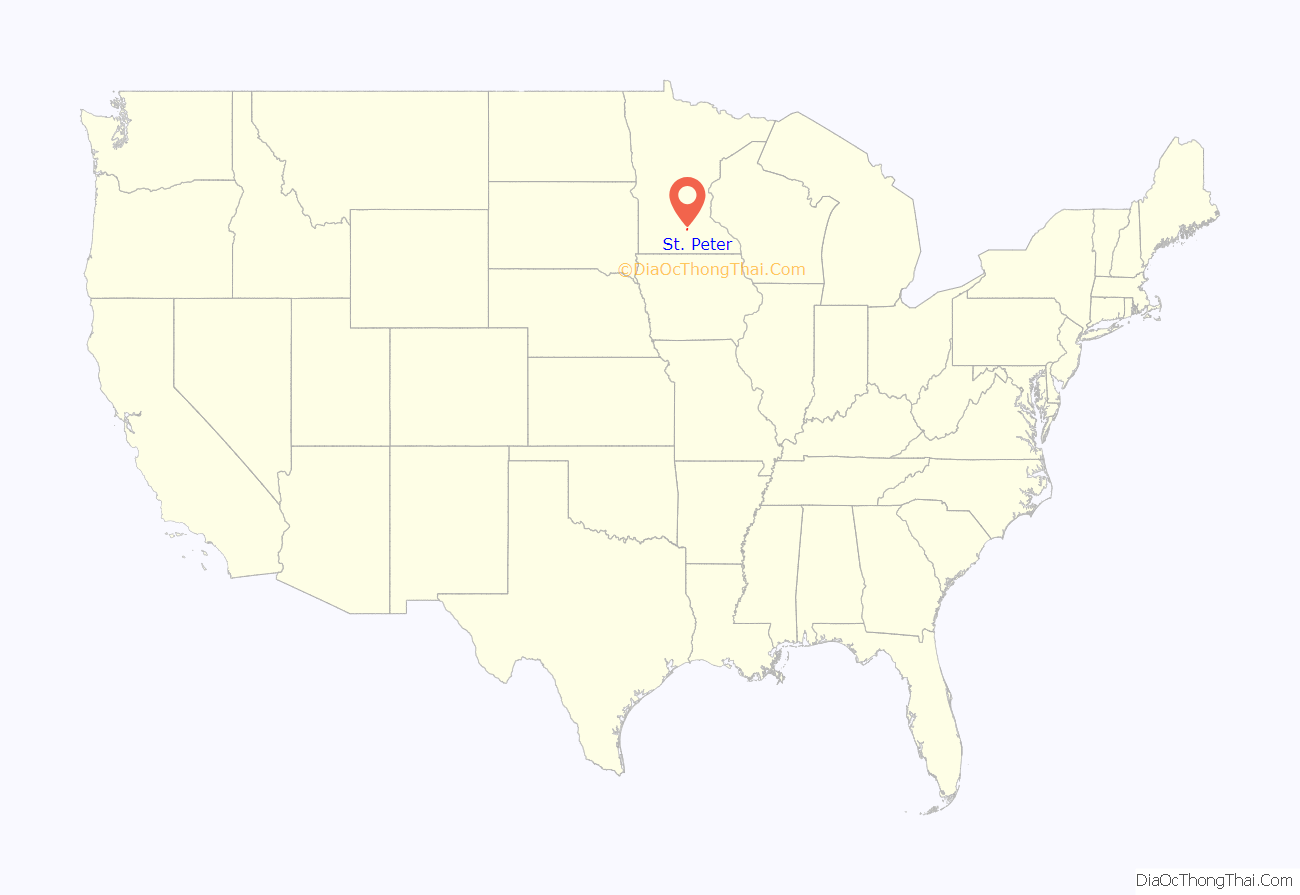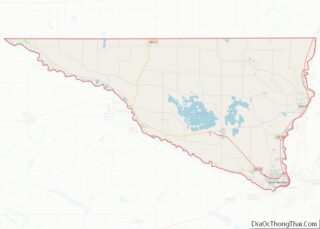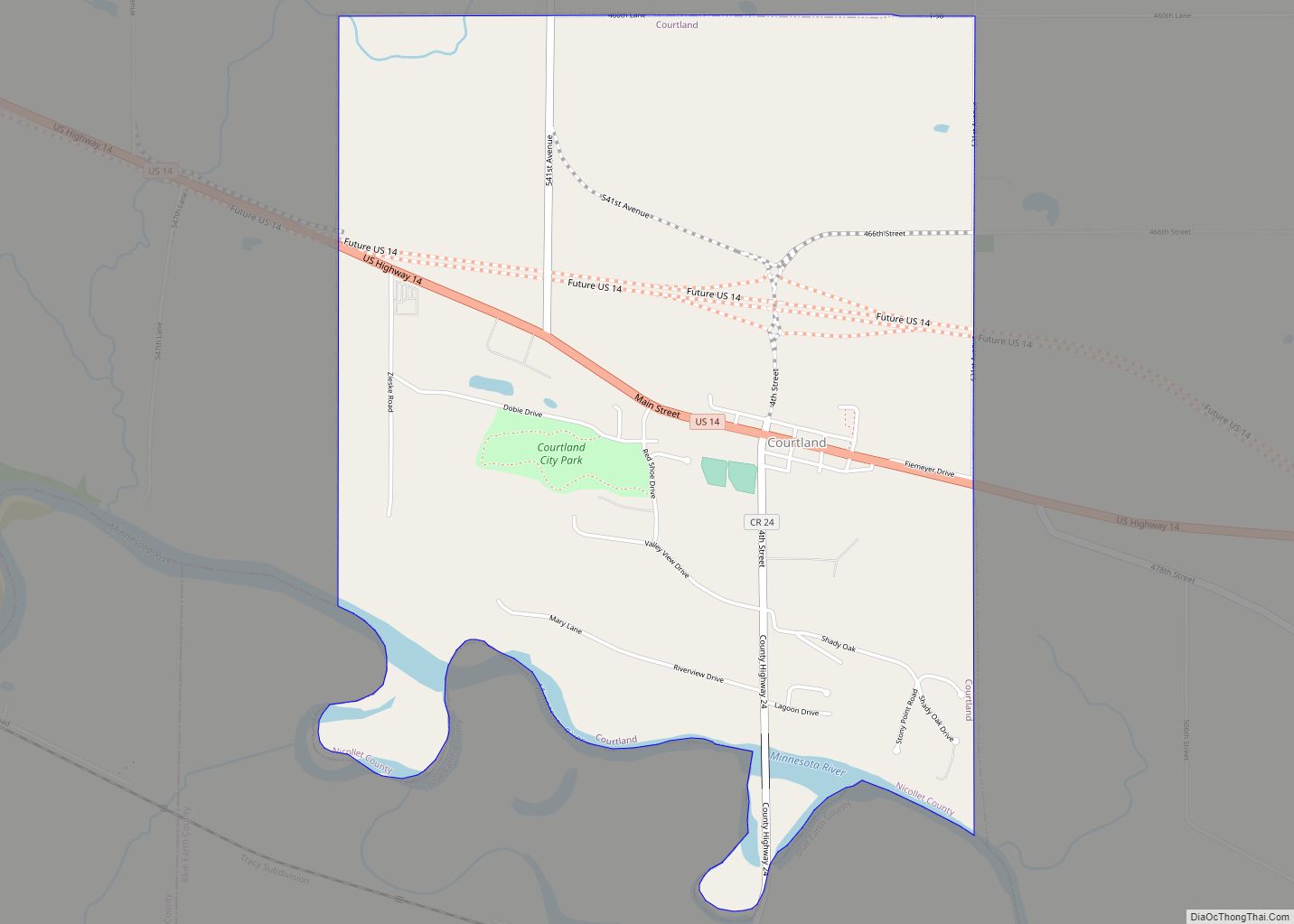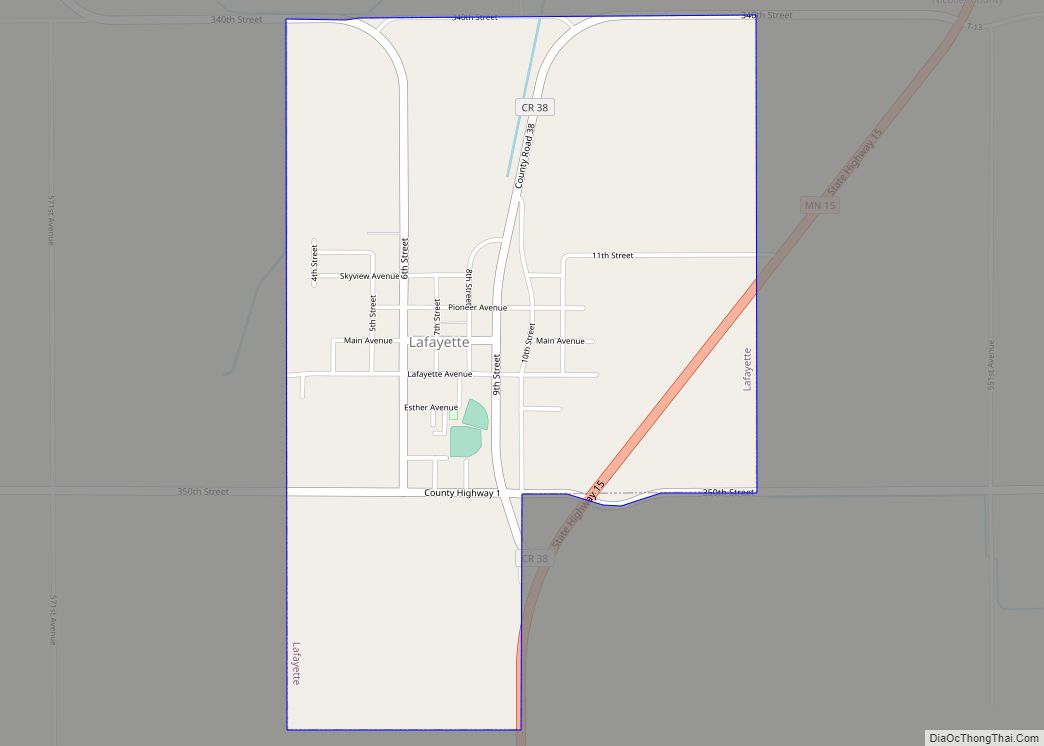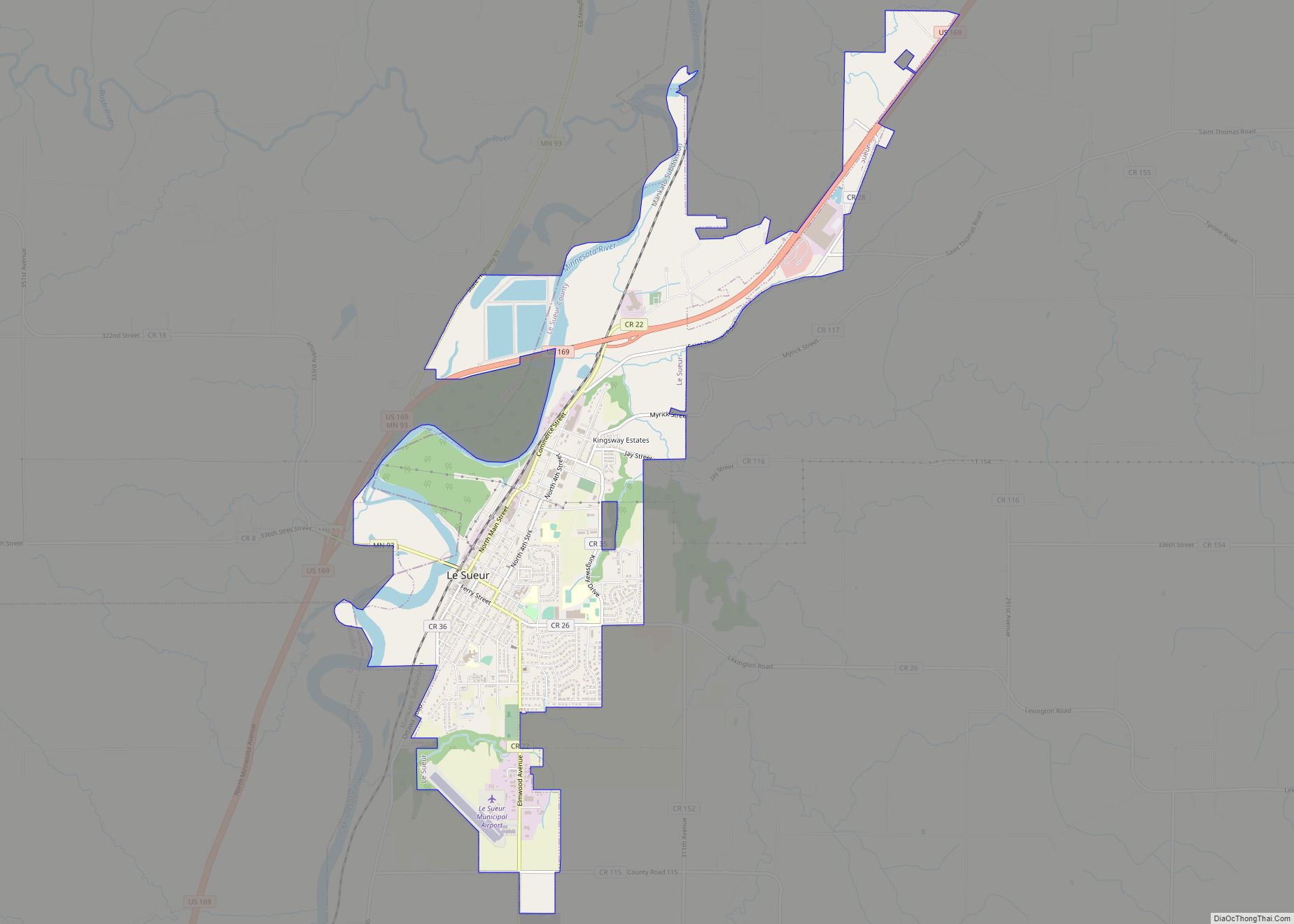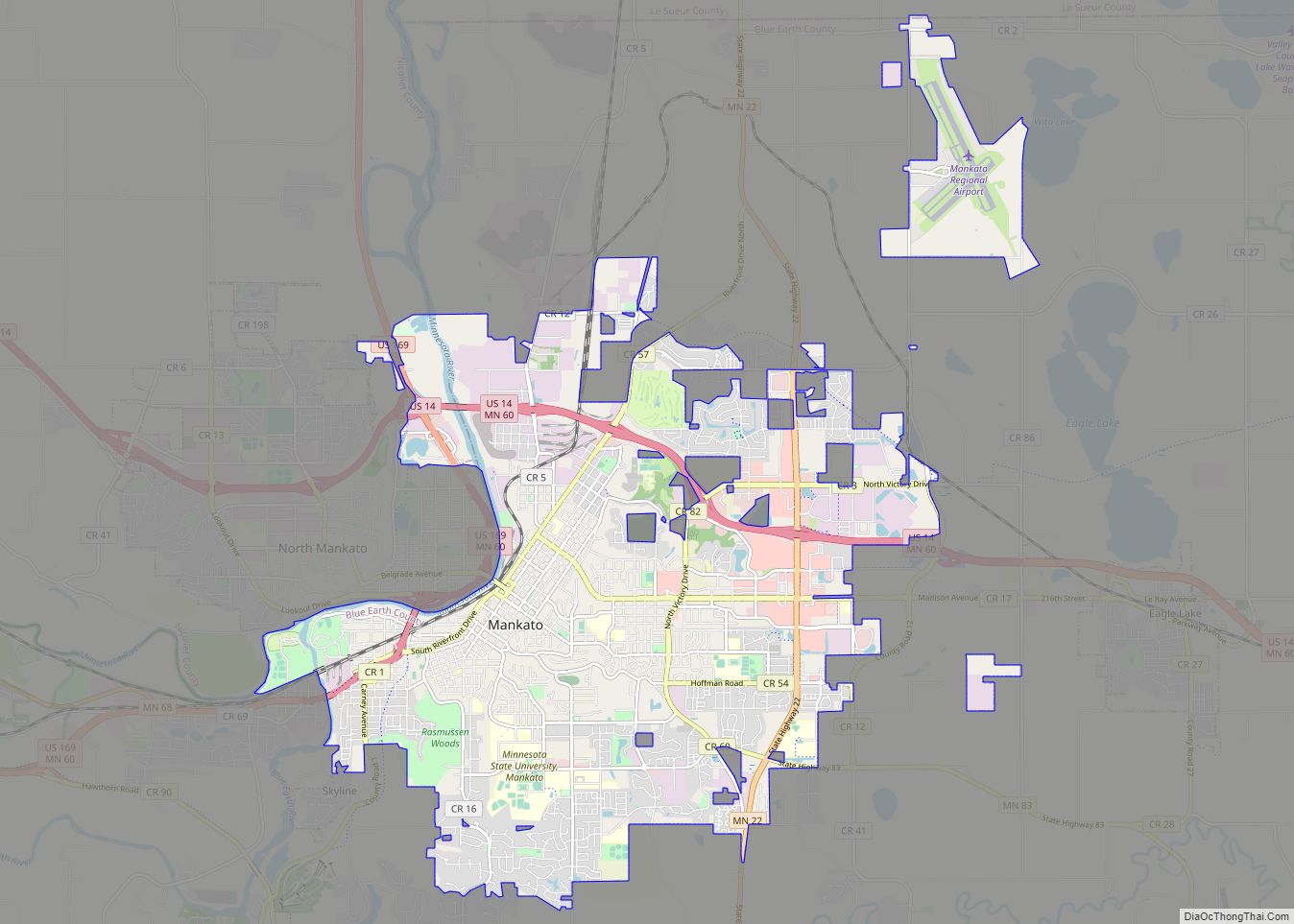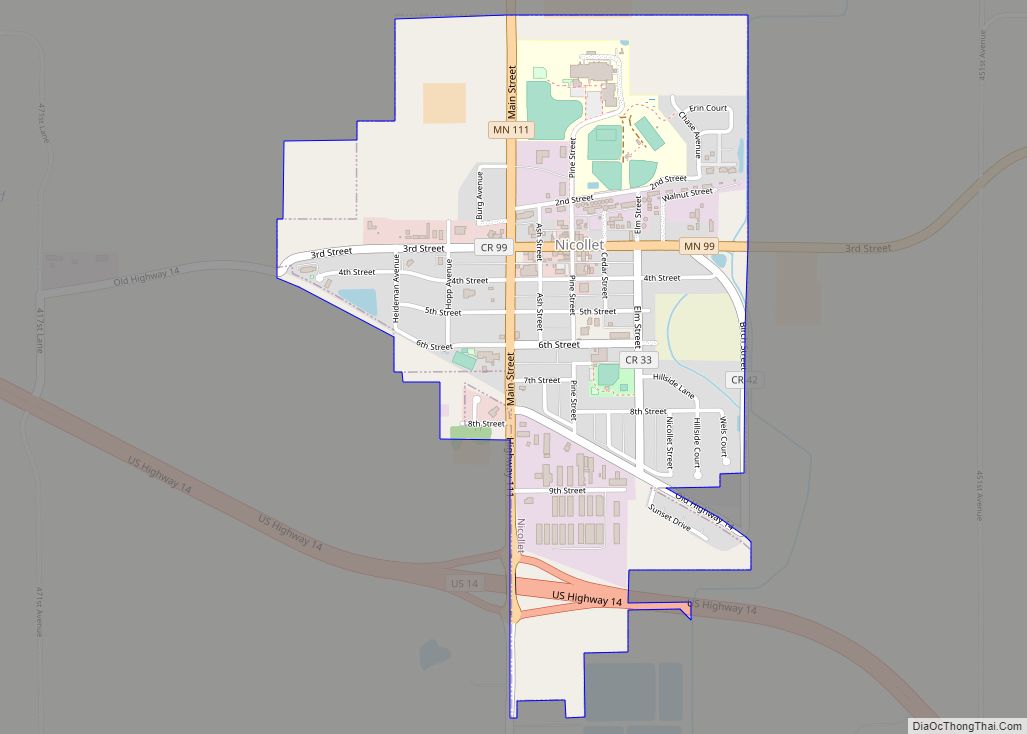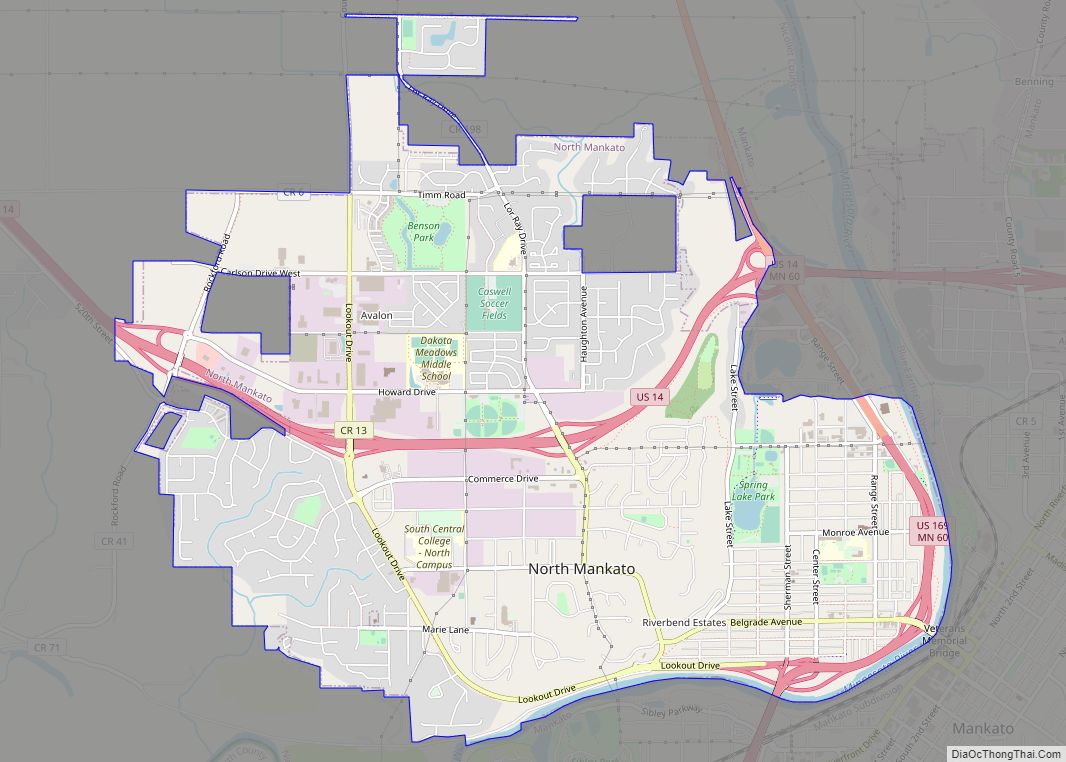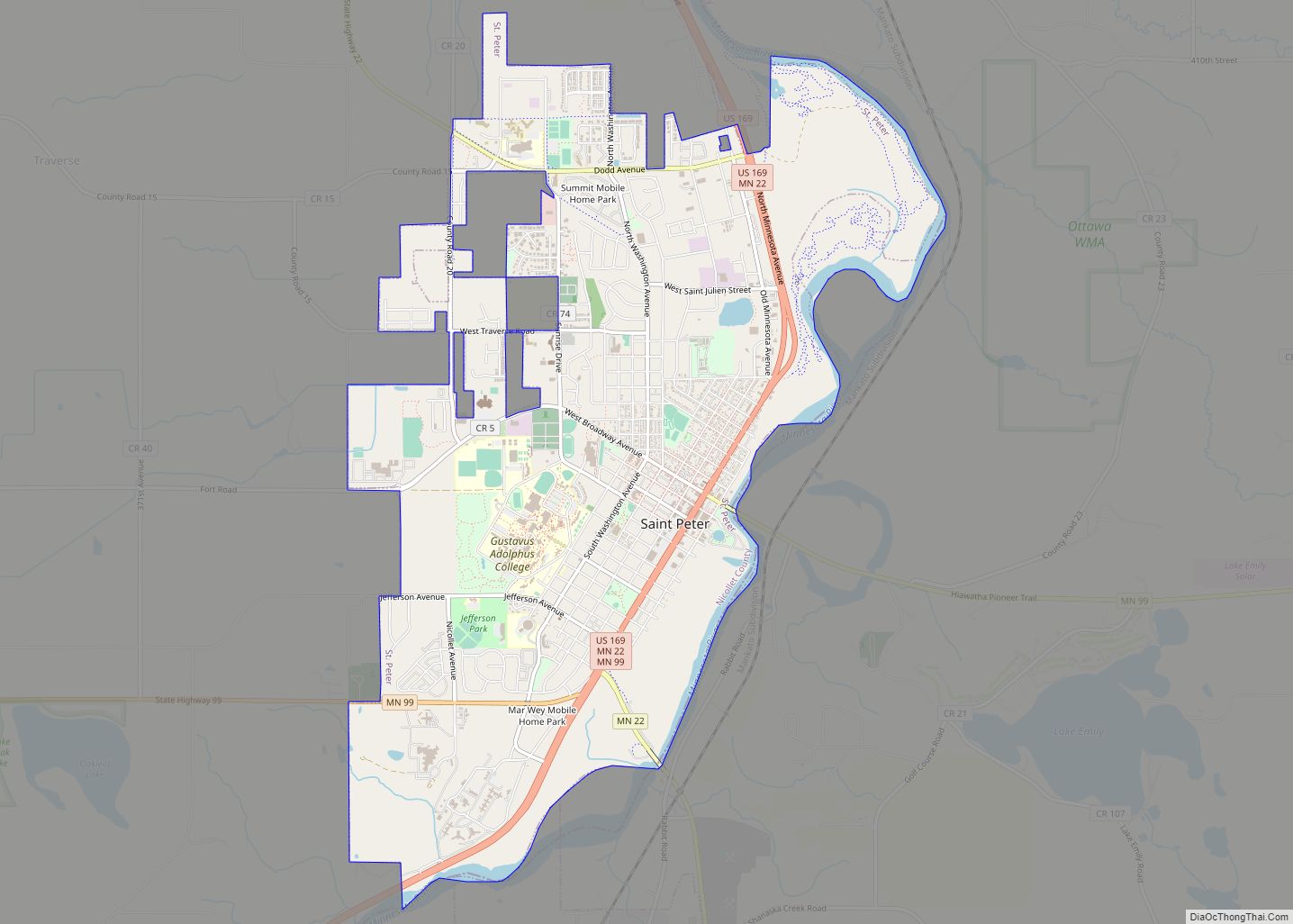St. Peter is a city in Nicollet County, Minnesota, United States. It is 10 miles north of the Mankato – North Mankato metropolitan area. The population was 12,066 at the 2020 census. St. Peter is the county seat of Nicollet County and home to Gustavus Adolphus College.
U.S. Highway 169 and Minnesota State Highways 22 and 99 are three of the city’s main routes.
St. Peter’s sister city is Petatlán, Guerrero, Mexico.
| Name: | St. Peter city |
|---|---|
| LSAD Code: | 25 |
| LSAD Description: | city (suffix) |
| State: | Minnesota |
| County: | Nicollet County |
| Founded: | 1853 |
| Incorporated: | 1873 |
| Elevation: | 768 ft (234 m) |
| Land Area: | 6.06 sq mi (15.70 km²) |
| Water Area: | 0.17 sq mi (0.45 km²) |
| Population Density: | 1,989.78/sq mi (768.30/km²) |
| ZIP code: | 56082 |
| Area code: | 507 |
| FIPS code: | 2758036 |
| GNISfeature ID: | 0651004 |
| Website: | saintpetermn.gov |
Online Interactive Map
Click on ![]() to view map in "full screen" mode.
to view map in "full screen" mode.
St. Peter location map. Where is St. Peter city?
History
St. Peter was founded in 1853 by Captain William Bigelow Dodd, who claimed 150 acres (0.61 km) north of what is now Broadway Avenue. He named the new settlement Rock Bend because of the rock formation at the bend of the Minnesota River. Daniel L. Turpin platted and surveyed the town site in 1854. In 1855, a group of St. Paul businessmen interested in promoting the town formed the Saint Peter Company, and the town was renamed St. Peter. The president of the company was Willis A. Gorman, Territorial Governor of Minnesota. Many of St. Peter’s streets were named after streets in New York City, including Park Row, Chatham, Broadway, Nassau, and Union. Dodd was originally from Bloomfield, New Jersey. His second wife, Harriett Newell Jones, a native of Cabot, Vermont, was living in New York at the time of their marriage at the Church of the Holy Communion in New York City, which helped fund the church in St. Peter that shares its name.
In 1857, an attempt was made to move the Territory of Minnesota’s capital from St. Paul to St. Peter. Gorman owned the land on which the bill’s sponsors wanted to build the new capitol building, and at one point had been heard saying, “If the capitol remains in Saint Paul, the territory is worth millions, and I have nothing.” At the time, St. Peter, in the territory’s central region, was seen as more accessible to far-flung territorial legislators than St. Paul, which was in the extreme east of the territory, on the east bank of the Mississippi River. A bill passed both houses of the Territorial Legislature and was awaiting Gorman’s signature. The chairman of the Territorial Council’s Enrolled Bills Committee, Joseph J. Rolette of Pembina, took the bill and hid in a St. Paul hotel, drinking and playing cards with some friends as the city police looked fruitlessly for him, until the end of the legislative session, too late for the bill to be signed. Rolette came into the chamber just as the session ended. Today, St. Paul is the state’s second-largest city (after neighboring Minneapolis), while St. Peter is a relatively small rural town.
In 1851 the Treaty of Traverse des Sioux was signed between the Sioux (Dakota) and the U.S. Government one mile (1.6 km) north of St. Peter. The Nicollet County Historical Society-Treaty Site History Center is near the site of the signing. But the treaty’s promises were not kept. The Dakota became angered and the Dakota War of 1862 began in Cottonwood County. In August 1862 the Dakota attacked the German settlement of New Ulm. A company of volunteers from St. Peter, headed by Dodd, St. Peter’s founder, went to New Ulm’s defense. Dodd was killed on August 23, 1862, and briefly buried in New Ulm. On November 11, 1862, Dodd was buried with high military honors in St. Peter on the grounds of the Church of the Holy Communion, Episcopal, on land he donated to the church. Dodd, his wife Harriet and two children are buried behind the present stone church built in 1869–70 at 118 North Minnesota Avenue.
In 1866, the legislature established the first “Minnesota Asylum for the Insane” in St. Peter. It was later known as the St. Peter State Hospital, and is now called the St. Peter Regional Treatment Center.
On July 1, 1892, the Sontag Brothers, John Sontag and George Contant, and their partner, Chris Evans, tried to rob a train between St. Peter and Kasota along the Minnesota River. The bandits acquired nothing of value, but their activities came under the review of Pinkerton detectives, and both were apprehended in June 1893 in what is called the Battle of Stone Corral in California.
Governors
St. Peter is known as the home of five governors:
- Territorial
- Willis Arnold Gorman (1853–1857)
- State
- Henry Adoniram Swift (1863–1864)
- Horace Austin (1870–1874)
- Andrew Ryan McGill (1887–1889)
- John Albert Johnson (1905–1909)
The best-known of these, Johnson, was born in St. Peter to Swedish-born parents on July 28, 1861. Because of family circumstances, he offered to help his mother raise the family. He left school at a young age and held a variety of jobs. In 1887, he was hired as editor of the St. Peter Herald, the local newspaper. In 1899, he was elected to the State Senate, and served until 1903. In 1904, he was elected Minnesota’s 16th governor. He was reelected in 1906 and 1908. He was considered as a possible candidate in the 1912 presidential election, but died as the result of an operation for intestinal adhesions in Rochester, Minnesota, on September 21, 1909. Drs. William James Mayo and Charles Horace Mayo, who came from Le Sueur and were friends with Johnson, performed the operation. After lying in state in the Capitol rotunda, his body was taken to St. Peter for burial. The funeral, held at Union Presbyterian Church, was St. Peter’s largest ever, and he was buried near his parents in Greenhill Cemetery. He was survived by his wife, Elinore “Nora” Preston Johnson.
Mayors
- Eugene St. Julien Cox 1865–1867 (also served in the state legislature and as a district court judge)
- Francis E. Lange 1868–1869
- William Schimmell 1870–1872 (First president of First National Bank)
- Albert Knight 1873–1875 (Knight Street is named after him)
- Addison L. Sackett 1876–1878 (also served as county auditor and in the state legislature)
- Azro A. Stone 1879 (also served as county sheriff; Stones’ Way and Stones’ Park are named after him)
- Philip Dick, Sr. 1880–1882
- Gustav W. Steinke 1883–1884
- Gideon S. Ives 1885 (son-in-law of Governor Henry Swift; served as lieutenant governor 1891–1893)
- Joseph A. Mason 1886–1888
- Philip Dick, Sr. 1889–1893 (second term as mayor)
- Henry Moll 1894–1895 (also served as a probate judge)
- Dr. Lewis M. Erickson 1896–1898
- Melville G. Hanscome 1899–1900
- William H. Mueller 1901–1905
- William H. Rounseville 1906
- Philip Dick, Sr. 1907–1909 (third term as mayor)
- Edward Bornemann 1910–1912
- Philip E. Dick, Jr. 1913–1914
- Edward Bornemann 1915
- Adolph Bornemann 1916–1917
- William Haesecke 1918–1920
- Lillien M. (Cox) Gault-Wolfe 1921–1922 (first woman mayor in Minnesota, daughter of former mayor E. St. Julien Cox)
- Edward Woehler 1921–1930
- Dr. Arthur H. Bittner 1931–1933 (Died in Office)
- Floyd B. Johnson 1933–1935 (athletic field at St. Peter Middle School (formerly St. Peter Middle/High School) is named after him)
- Otto T. Miller 1936–1937
- Reuben R. Seibert 1938–1940
- Otto T. Miller 1941–1942
- Henry B. Seitzer 1942–1943
- Andrew Cook 1944 (Died in office)
- John R. Faust 1944–1946
- Henry E. Wiest 1946
- Clifford J. Nutter 1947–1948
- Elmer J. Kleifgen 1949–1951
- Prof. George W. Anderson 1951–1952 (English professor at Gustavus Adolphus College)
- Richard Konechne 1953–1956
- Leighton R. Swenson 1957–1958
- Mark W. Schaus 1959–1960
- George W. Martens 1960–1961
- Arthur W. Cook 1962–1963
- Lamar Hay 1964–1965
- George W. Martens 1966–1970
- Douglas C. Pyan 1971–1985
- William A. Wettergren 1986–1989
- Peter J. Rheaume 1990–1991
- Ellery O. Peterson 1992–1995
- Jerry K. Hawbaker 1996–2005
- Timothy J. Strand 2006–2015
- Chuck Zieman 2016–2021
- Shanon Nowell 2022–present (Administrator at Gustavus Adolphus College)
Tornado
On March 29, 1998, a tornado struck St. Peter, killing six-year-old Dustin Schneider, injuring dozens more, and damaging much of the town’s housing, commercial, and civic buildings. The tornado destroyed 156 single-family houses and 51 apartment units. An additional 362 houses and apartments suffered serious damage and 1,383 houses or apartments had minor damage. The town’s three trailer parks were largely spared with no mobile homes destroyed and just two seriously damaged. Major losses included the Old Central School, St. Peter Arts and Heritage Center, St. Peter’s Catholic Church, St. Peter Evangelical Lutheran Church, and Johnson Hall at Gustavus Adolphus College.
Churches
- Bethany Alliance Church (Christian & Missionary Alliance) Established in 1961, Present church built in 1965, Church renamed Living Truth Fellowship in 2015.
- Calvary Baptist Church Established in 1963, Present Church built in 1977
- Church of St. Peter (Roman Catholic) Established in 1856, Present church built in 2001
- Church of the Holy Communion (Episcopal) Established in 1854 Present church built in 1869–1870
- First Lutheran Church (ELCA) Established in 1857 Present Church built in 1965
- Good Samaritan United Methodist Church Established in 2010, no church at present time
- Sunrise Assembly of God Established in 1934, present church built in 1988
- St. Peter’s Evangelical Lutheran Church (WELS) Established in 1867, Present church built in 1999
- River of Life Lutheran Church (LCMS) Established in 2013 by Our Savior’s Lutheran Church of Mankato, has been a member of the Lutheran Church–Missouri Synod since 2016.
- Trinity Lutheran Church (ELCA) Established in 1892, Present church built in 1988
- Union Presbyterian Church Established in 1869 as a result of the union of two congregations, the First Free Presbyterian Church of Traverse des Sioux Established in 1853, and the First Presbyterian Church of St. Peter Established in 1857. The present church was built in 1871.
- Christ Chapel (ELCA) Built from 1959–1961, inaugurated in 1962. On the campus of Gustavus Adolphus College.
St. Peter Road Map
St. Peter city Satellite Map
Geography
According to the United States Census Bureau, the city has an area of 6.24 sq mi (16.16 km), of which 6.06 sq mi (15.70 km) is land and 0.17 sq mi (0.44 km) is water.
Climate
See also
Map of Minnesota State and its subdivision:- Aitkin
- Anoka
- Becker
- Beltrami
- Benton
- Big Stone
- Blue Earth
- Brown
- Carlton
- Carver
- Cass
- Chippewa
- Chisago
- Clay
- Clearwater
- Cook
- Cottonwood
- Crow Wing
- Dakota
- Dodge
- Douglas
- Faribault
- Fillmore
- Freeborn
- Goodhue
- Grant
- Hennepin
- Houston
- Hubbard
- Isanti
- Itasca
- Jackson
- Kanabec
- Kandiyohi
- Kittson
- Koochiching
- Lac qui Parle
- Lake
- Lake of the Woods
- Lake Superior
- Le Sueur
- Lincoln
- Lyon
- Mahnomen
- Marshall
- Martin
- McLeod
- Meeker
- Mille Lacs
- Morrison
- Mower
- Murray
- Nicollet
- Nobles
- Norman
- Olmsted
- Otter Tail
- Pennington
- Pine
- Pipestone
- Polk
- Pope
- Ramsey
- Red Lake
- Redwood
- Renville
- Rice
- Rock
- Roseau
- Saint Louis
- Scott
- Sherburne
- Sibley
- Stearns
- Steele
- Stevens
- Swift
- Todd
- Traverse
- Wabasha
- Wadena
- Waseca
- Washington
- Watonwan
- Wilkin
- Winona
- Wright
- Yellow Medicine
- Alabama
- Alaska
- Arizona
- Arkansas
- California
- Colorado
- Connecticut
- Delaware
- District of Columbia
- Florida
- Georgia
- Hawaii
- Idaho
- Illinois
- Indiana
- Iowa
- Kansas
- Kentucky
- Louisiana
- Maine
- Maryland
- Massachusetts
- Michigan
- Minnesota
- Mississippi
- Missouri
- Montana
- Nebraska
- Nevada
- New Hampshire
- New Jersey
- New Mexico
- New York
- North Carolina
- North Dakota
- Ohio
- Oklahoma
- Oregon
- Pennsylvania
- Rhode Island
- South Carolina
- South Dakota
- Tennessee
- Texas
- Utah
- Vermont
- Virginia
- Washington
- West Virginia
- Wisconsin
- Wyoming
